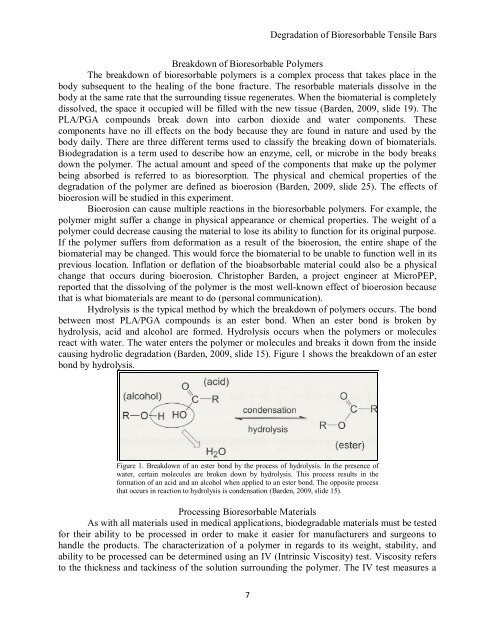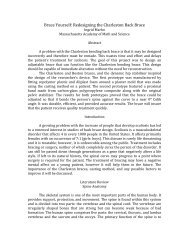A Study of Tensile Degradation of Bioresorbable Materials Used for ...
A Study of Tensile Degradation of Bioresorbable Materials Used for ...
A Study of Tensile Degradation of Bioresorbable Materials Used for ...
Create successful ePaper yourself
Turn your PDF publications into a flip-book with our unique Google optimized e-Paper software.
<strong>Degradation</strong> <strong>of</strong> <strong>Bioresorbable</strong> <strong>Tensile</strong> Bars<br />
Breakdown <strong>of</strong> <strong>Bioresorbable</strong> Polymers<br />
The breakdown <strong>of</strong> bioresorbable polymers is a complex process that takes place in the<br />
body subsequent to the healing <strong>of</strong> the bone fracture. The resorbable materials dissolve in the<br />
body at the same rate that the surrounding tissue regenerates. When the biomaterial is completely<br />
dissolved, the space it occupied will be filled with the new tissue (Barden, 2009, slide 19). The<br />
PLA/PGA compounds break down into carbon dioxide and water components. These<br />
components have no ill effects on the body because they are found in nature and used by the<br />
body daily. There are three different terms used to classify the breaking down <strong>of</strong> biomaterials.<br />
Biodegradation is a term used to describe how an enzyme, cell, or microbe in the body breaks<br />
down the polymer. The actual amount and speed <strong>of</strong> the components that make up the polymer<br />
being absorbed is referred to as bioresorption. The physical and chemical properties <strong>of</strong> the<br />
degradation <strong>of</strong> the polymer are defined as bioerosion (Barden, 2009, slide 25). The effects <strong>of</strong><br />
bioerosion will be studied in this experiment.<br />
Bioerosion can cause multiple reactions in the bioresorbable polymers. For example, the<br />
polymer might suffer a change in physical appearance or chemical properties. The weight <strong>of</strong> a<br />
polymer could decrease causing the material to lose its ability to function <strong>for</strong> its original purpose.<br />
If the polymer suffers from de<strong>for</strong>mation as a result <strong>of</strong> the bioerosion, the entire shape <strong>of</strong> the<br />
biomaterial may be changed. This would <strong>for</strong>ce the biomaterial to be unable to function well in its<br />
previous location. Inflation or deflation <strong>of</strong> the bioabsorbable material could also be a physical<br />
change that occurs during bioerosion. Christopher Barden, a project engineer at MicroPEP,<br />
reported that the dissolving <strong>of</strong> the polymer is the most well-known effect <strong>of</strong> bioerosion because<br />
that is what biomaterials are meant to do (personal communication).<br />
Hydrolysis is the typical method by which the breakdown <strong>of</strong> polymers occurs. The bond<br />
between most PLA/PGA compounds is an ester bond. When an ester bond is broken by<br />
hydrolysis, acid and alcohol are <strong>for</strong>med. Hydrolysis occurs when the polymers or molecules<br />
react with water. The water enters the polymer or molecules and breaks it down from the inside<br />
causing hydrolic degradation (Barden, 2009, slide 15). Figure 1 shows the breakdown <strong>of</strong> an ester<br />
bond by hydrolysis.<br />
Figure 1. Breakdown <strong>of</strong> an ester bond by the process <strong>of</strong> hydrolysis. In the presence <strong>of</strong><br />
water, certain molecules are broken down by hydrolysis. This process results in the<br />
<strong>for</strong>mation <strong>of</strong> an acid and an alcohol when applied to an ester bond. The opposite process<br />
that occurs in reaction to hydrolysis is condensation (Barden, 2009, slide 15).<br />
Processing <strong>Bioresorbable</strong> <strong>Materials</strong><br />
As with all materials used in medical applications, biodegradable materials must be tested<br />
<strong>for</strong> their ability to be processed in order to make it easier <strong>for</strong> manufacturers and surgeons to<br />
handle the products. The characterization <strong>of</strong> a polymer in regards to its weight, stability, and<br />
ability to be processed can be determined using an IV (Intrinsic Viscosity) test. Viscosity refers<br />
to the thickness and tackiness <strong>of</strong> the solution surrounding the polymer. The IV test measures a<br />
7
















